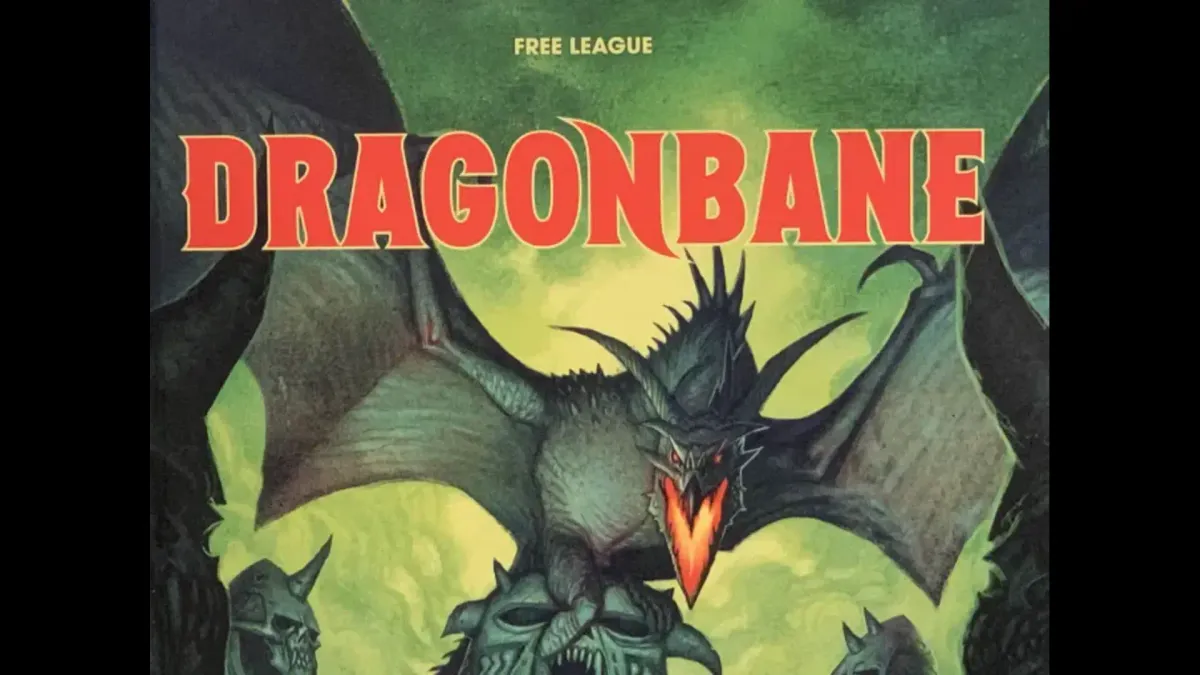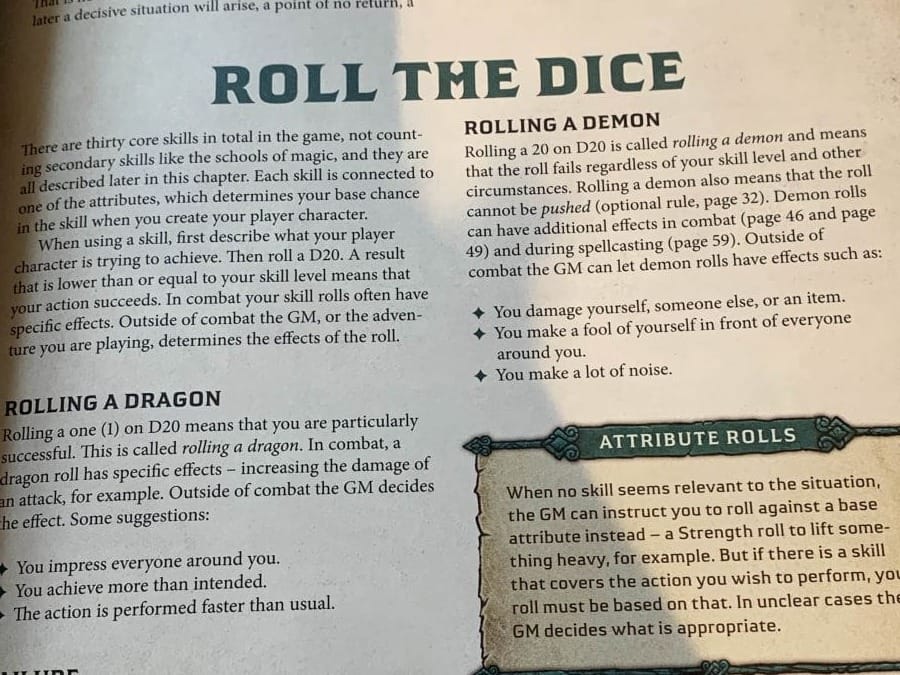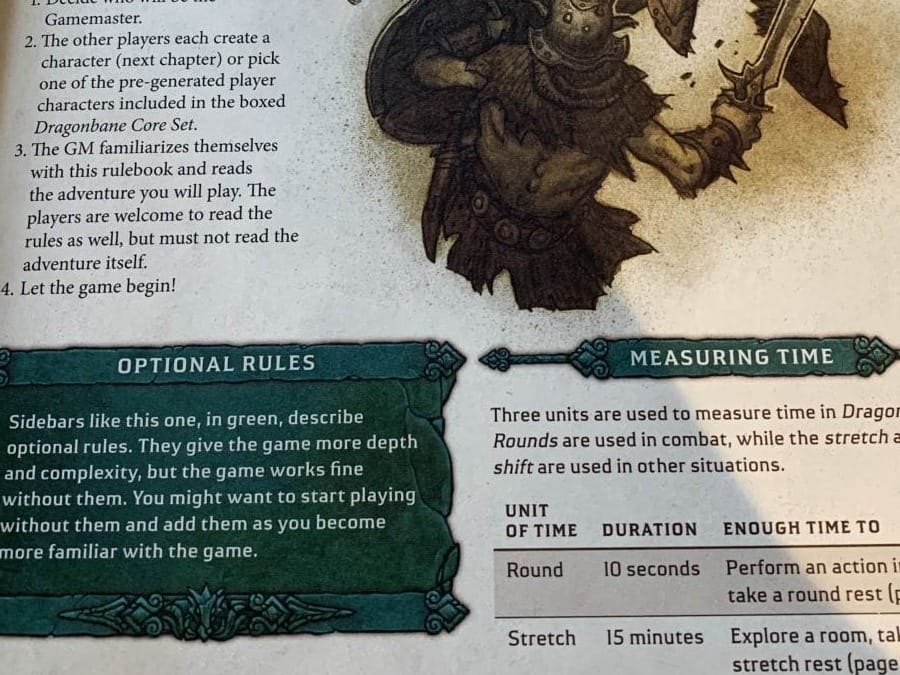
Dragonbane is a fantasy role-playing game by Free League. Inside this rulebook, you’ll find a fast D-20-based ruleset plus an introductory adventure. Dragonbane is light; it has 113 pages, but don’t let that stop you from playing.
Dragonbane took me by surprise because I don’t normally like small role-playing games. And while I did have some issues with the book and its length, it didn’t stop me from enjoying what this game had to offer. Dragonbane is a D-20-based game where you aim to roll under to succeed. If this is the first game you’ve played where you’re rolling under, don’t worry, it’s exceptionally easy to get the hang of.
Starting the game
The first thing I look at with any tabletop roleplaying game book is the writing and layout. Dragonbane had me worried because I am used to smaller games cutting corners in order to keep the game as light as possible.
The layout and flow of Dragonbane are fantastic! The pictures are non-intrusive, and the cut-off for paragraphs is great. I especially appreciate that none of the paragraphs seems to have awkward cut-off points. The artwork itself is gorgeous and fits the theme of the game overall.
Character creation is done in a few steps:
- Choose your Kin.
- Choose your Profession.
- Choose your Age.
- Choose your Name.
- Roll for your attributes.
- Calculate your derived ratings.
- Choose your trained skills.
- Choose your weaknesses (this is an optional thing.)
- Choose your gear.
- Choose your memento (another optional step)
- Choose your appearance.
Dragonbane features 6 different Kin in the Core Rulebook. Kin is this game's version of a race, and the 6 to choose from are Human, Halfling, Dwarf, Elf, Mallard, and Wolfkin. You’re only going to get a paragraph of lore for each of the Kin, and for me, that was enough because we primarily played in a homebrew setting.

After choosing your Kin, we jump over to Professions. These are similar to having a Class like you would see from Dungeons and Dragons, but they function differently. Each Profession has a snippet of lore to get your brain going on how the Profession will function. It also tells you your Key Attribute, Skills, Heroic Ability, and has space for you to roll for Gear and a nickname. There are 10 Professions in the Dragonbane Rulebook.
- Artisan
- Bard
- Fighter
- Hunter
- Knight
- Mage
- Mariner
- Merchant
- Scholar
- Thief
Next up, we have our Age, and this does have gameplay ramifications, which I appreciate. The older your adventurer is, the lower your attributes are going to be at the start, but you get higher skill ratings. I love this because it makes character creation feel like it has some weight to it. After this, you can simply choose a name or roll one.
Now your attributes go as follows:
- Strength: Your raw power.
- Constitution: Physical fitness and resistance.
- Agility: Body control, speed, and fine motor skills.
- Intelligence: Mental acuity, intellect, and reasoning skills.
- Willpower: Self-discipline and focus.
- Charisma: Force of personality and empathy.
To get these ability scores, you roll a 4D6 and drop the worst die. It will give you a score between 3 and 18, and you simply assign the score to the ability of your choosing until you have a score for each attribute. After this, you get to your Derived Ratings, which are your movement, Damage Bonus, Hit Points, and Willpower Points. This is where Dragonbane shines; the way the book flows from one step to another is extremely smooth, and each step is beautifully explained. Playing this game with a group of new players was a breeze because
Skills are up next, and I love the way Dragonebane does this. So, each Skill has a base chance. You want the highest skill rating possible on a scale of 1-18, but don’t worry, your character doesn’t become completely useless if you have a few low numbers.
The thing with Dragonbane is that the game is lightweight, and because the writing was nailed, you’re not going to struggle through character creation. With a group of new players and me being an experienced Game Master, we got through character creation in 1 hour and 40 minutes.
Mechanics and Feel
As stated at the start of this article, Dragonbane is a roll under game. This means that a 1 is a critical success and a 20 is a critical failure. Dragonbane has its own language and terminology for this, but I find that it is best to keep things simple. Something that my group loved is that there is a distinct lack of crunch here, and because of that, you can expect combat to flow faster once everyone gets the hang of the game.

You also will be leveling up your skills throughout character development; there are no character levels in this game. Character progression still feels great, though, and the skill advancement is really smooth: Everything about the mechanics for Dragonbane feels well-playtested and designed, and the more you play it, the more you can tell that a lot of care went into making sure everyone at the table was having fun. The skill list is mighty too, there is something for every playstyle, and enough to make each Profession feel unique.
The Action and Movement section has rules that make a lot of sense and are well-explained. Each explanation provided in the book rarely leaves room for interpretation in this section. For example, the actions chart on page 42 provides clear and concise rules for when those elements pop up in the game. I call attention to this because you’ll find that not many of the rules leave room for interpretation at all. Because of this, when a character is taking an Action, we are able to have a dramatically faster gaming experience.
Another thing that stood out to me is that this is a low-magic game. One of the Professions is a spellcaster, and the whole spell list reads like something you would get at the start of a Dungeons and Dragons game. You won’t find much in the way of an established setting here. My friends and I had to use Wikipedia plus all of the lore that we could find in the rulebook, to put it together.
Final Thoughts
Dragonbane does not have a section dedicated to being a game master, and I find that odd. If you were completely new to tabletop roleplaying games, you could struggle because of this. It also feels like an unnecessary thing to cut. There is a small section in the back that covers the role of the game master and general adventures, but this section only spans pages 101-113. While I do like the plethora of tables provided, I do feel like there was some space in this book to include more details.
Dragonbane Rulebook
Excellent
Dragonbane is a rules-light tabletop roleplaying game that does the low magic setting justice. The writing and editing are top-notch, and this game is a lot of fun.
Pros
- Fresh twists on classic fantasy classes.
- Lightweight combat that makes running it easy.
- Tons of tables that make the game feel fresh.
- Fantastic editing and layout.
Cons
- No game masters section.
This review is based on a retail copy provided by the publisher.
